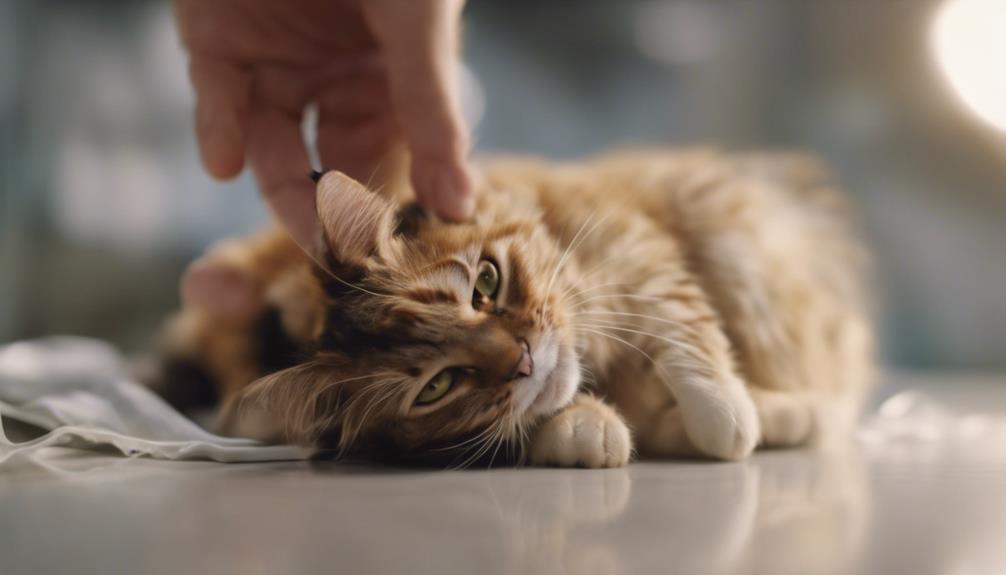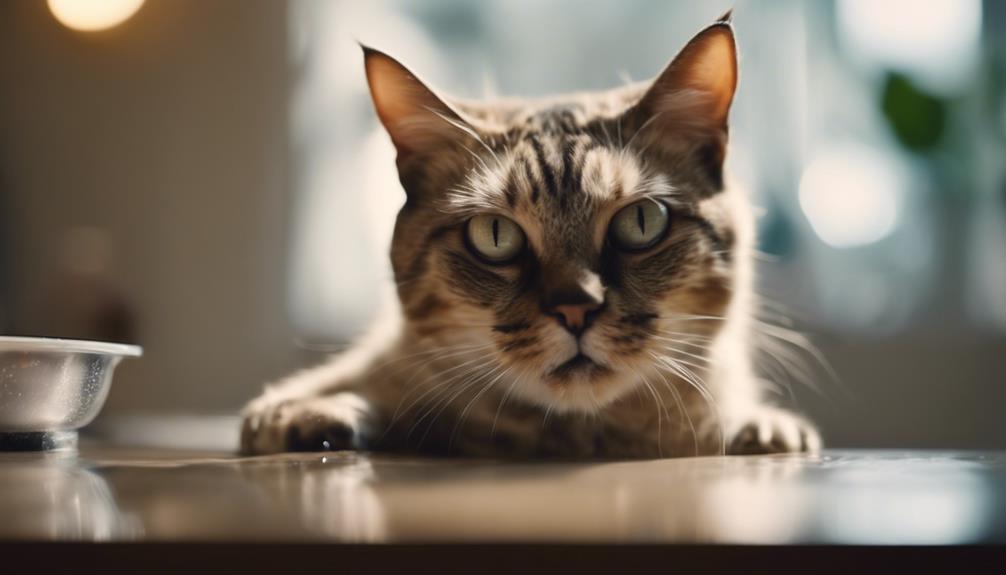Exploring the nuances of cat dehydration unveils a critical aspect of feline health that demands meticulous attention. As devoted pet owners, understanding the subtle signs of dehydration in our feline companions can be a gateway to ensuring their vitality and well-being.
From the telltale symptoms that signal a potential issue to the array of treatment options available, the journey to rehydrating your kitty encompasses a blend of vigilance and care.
Stay tuned to unravel the intricate web of cat dehydration, delving into effective strategies that can make a substantial difference in your cat's hydration levels and overall health.
Key Takeaways
- Early recognition and intervention are crucial for managing cat dehydration effectively.
- Veterinary care is essential for proper evaluation and treatment of dehydration in cats.
- Home remedies like diluted wet food can aid in mild cases of cat dehydration.
- Prevent dehydration by ensuring constant access to fresh water and monitoring your cat's behavior.
Causes of Cat Dehydration
Dehydration in cats can stem from various factors, including insufficient fluid intake due to conditions such as vomiting, diarrhea, reduced wet food consumption, limited water access, and underlying health issues like kidney disease. Cats are meticulous groomers, and if they are feeling unwell, they may decrease their water intake, leading to dehydration.
Additionally, older cats or those with chronic conditions may be more prone to dehydration. It is crucial for cat owners to monitor their feline companions closely for any changes in water consumption or signs of illness that could contribute to dehydration.
Symptoms of Dehydration in Cats
How can cat owners recognize the early signs of inadequate hydration in their feline companions? Dehydration in cats can manifest through various symptoms, indicating the need for immediate attention to ensure your cat's well-being. Here are some key signs to watch for:
- Dry or sticky gums
- Sunken eyes
- Lethargy or weakness
- Reduced skin elasticity
Being attuned to these signs can help you detect dehydration early, allowing you to take prompt action to address your cat's fluid needs. Remember, early intervention is crucial in preventing dehydration from progressing to a severe state.
Skin Turgor Test for Dehydration

When assessing dehydration in cats, the skin turgor test serves as a valuable diagnostic tool for determining the level of hydration. This simple yet effective test involves gently lifting the skin on the back of your cat's neck and observing how quickly it returns to its normal position.
In well-hydrated cats, the skin will snap back promptly, while in dehydrated cats, the skin may take longer to return or remain tented. Monitoring the skin turgor regularly can help you gauge your cat's hydration status and prompt you to seek veterinary care if dehydration is suspected.
Treatment Options for Dehydration
Assessing dehydration in cats is crucial for determining appropriate treatment options to restore optimal hydration levels. When addressing dehydration in your feline companion, consider the following treatment options:
- Veterinary Care: Seek professional evaluation and treatment to address dehydration effectively.
- Hydration Solutions: Veterinarians have various methods, including intravenous fluids, to help rehydrate your cat.
- Mild Cases: Home remedies like offering water from a can of tuna or adding water to wet food can benefit mild dehydration.
- Caution: Avoid using human dehydration solutions such as Pedialyte or sports drinks, as they may not be safe for cats.
Home Remedies for Dehydration

Cat owners can implement practical home remedies to aid in the hydration of their feline companions. When immediate veterinary care is not accessible, simple remedies can make a difference. Below are some home remedies that can help in hydrating your cat:
| Home Remedies | Description |
|---|---|
| Offer water from a can of tuna | The tuna juice can entice your cat to drink more water. |
| Dilute wet food | Adding water to wet food can increase fluid intake. |
| Encourage water consumption | Experiment with different methods to motivate your cat to drink. |
| Rest before reintroducing food and water | Resting can help your cat recover before resuming normal eating and drinking habits. |
These simple approaches can be beneficial in managing dehydration at home. Remember, consulting with a veterinarian is always advisable for personalized guidance.
Preventing Dehydration in Cats
To maintain optimal hydration levels in feline companions, cat owners should prioritize implementing preventive measures that promote consistent access to clean, fresh water and encourage fluid intake through strategic methods.
- Constant Water Access: Ensure your cat always has access to clean, fresh water to promote hydration.
- Creative Water Sources: Use fountains or faucets to make water more enticing for your cat.
- Wet Food Transition: Transitioning to wet food can increase your cat's fluid intake.
- Collaborative Vet Care: Work with your vet to develop effective hydration strategies tailored to your cat's specific needs.
Frequently Asked Questions
Can Dehydration in Cats Be Caused by Stress or Anxiety?
Dehydration in cats is usually caused by factors like insufficient fluid intake, health conditions, or gastrointestinal issues, rather than solely stress or anxiety. Recognizing dehydration symptoms promptly and providing proper hydration solutions through veterinary care is crucial.
Are There Specific Breeds of Cats That Are More Prone to Dehydration?
Certain cat breeds, like Persians, are predisposed to dehydration due to their long fur, which may hinder water consumption. Monitoring water intake and environmental factors is crucial for breeds prone to dehydration, ensuring optimal health and hydration levels.
How Can Environmental Factors Like Temperature Impact a Cat's Hydration Levels?
Environmental factors like temperature can significantly impact a cat's hydration levels. High temperatures can lead to increased water loss through panting and evaporation, making it crucial to provide ample fresh water and cool areas for cats to prevent dehydration.
What Role Does Age Play in the Likelihood of a Cat Experiencing Dehydration?
Age can impact a cat's susceptibility to dehydration. Older cats may have reduced kidney function, making them more prone to dehydration. Regular monitoring of water intake and seeking veterinary care promptly can help mitigate dehydration risks in aging felines.
Are There Alternative Hydration Methods, Such as Electrolyte Supplements, That Can Be Beneficial for Dehydrated Cats?
Alternative hydration methods for dehydrated cats may include electrolyte supplements; however, it is crucial to consult a veterinarian before administering any such products. Professional guidance ensures the safety and effectiveness of hydration strategies tailored to your cat's specific needs.
Conclusion
In conclusion, recognizing the causes, symptoms, and treatment options for cat dehydration is crucial for maintaining the well-being of feline companions.
Implementing preventive measures and seeking prompt veterinary care can help address dehydration effectively.
By staying informed and proactive in monitoring hydration levels, cat owners can ensure their pets receive the necessary care to stay healthy and hydrated.




